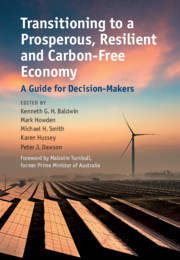Book contents
- Transitioning to a Prosperous, Resilient and Carbon-Free Economy
- Transitioning to a Prosperous, Resilient and Carbon-Free Economy
- Copyright page
- Dedication
- Contents
- Figures
- Tables
- Contributors
- Foreword
- Introduction
- 1 Policy Frameworks and Institutions for Decarbonisation: The Energy Sector as ‘Litmus Test’
- Technologies for Decarbonising the Electricity Sector
- 2 Wind Energy
- 3 Solar Photovoltaics
- 4 Solar Thermal Energy
- 5 Nuclear Energy
- 6 Hydropower
- 7 Energy Storage
- 8 The Hydrogen Economy
- Example Economies
- Cities and Industry
- Land Use, Forests and Agriculture
- Mining, Metals, Oil and Gas
- Addressing Barriers io Change
- Index
- References
6 - Hydropower
from Technologies for Decarbonising the Electricity Sector
Published online by Cambridge University Press: 08 October 2021
- Transitioning to a Prosperous, Resilient and Carbon-Free Economy
- Transitioning to a Prosperous, Resilient and Carbon-Free Economy
- Copyright page
- Dedication
- Contents
- Figures
- Tables
- Contributors
- Foreword
- Introduction
- 1 Policy Frameworks and Institutions for Decarbonisation: The Energy Sector as ‘Litmus Test’
- Technologies for Decarbonising the Electricity Sector
- 2 Wind Energy
- 3 Solar Photovoltaics
- 4 Solar Thermal Energy
- 5 Nuclear Energy
- 6 Hydropower
- 7 Energy Storage
- 8 The Hydrogen Economy
- Example Economies
- Cities and Industry
- Land Use, Forests and Agriculture
- Mining, Metals, Oil and Gas
- Addressing Barriers io Change
- Index
- References
Summary
Hydropower is the largest source of renewable energy in the world; it is expected at least to double by 2050. This chapter reviews how benefits from hydropower can be maximised while reducing environmental and social impacts. The scope for expansion of hydropower is considerable, but adverse environmental and social impacts need to be managed. Climate change is impacting hydro generation through changed snow melts and river flows, greater evaporation and more frequent extreme events, such as flooding and droughts. Hydropower infrastructure needs to have margins to cope with extreme events and adapt to changing conditions. Relicensing at specified intervals can provide a framework for renovation, removal or changes to minimise impacts and maximise benefits of dams. Planning of dams needs to be undertaken on a whole-of-river-basin scale . The World Commission on Dams (2000) recommended priorities for more sustainable development. The Hydropower Sustainability Assessment Protocol is one codification of better hydropower development practices. Hydropower is important in providing storage and firming capacity to complement intermittent generation from solar and wind generators.
- Type
- Chapter
- Information
- Transitioning to a Prosperous, Resilient and Carbon-Free EconomyA Guide for Decision-Makers, pp. 125 - 138Publisher: Cambridge University PressPrint publication year: 2021

